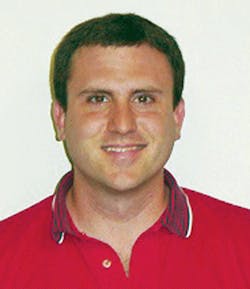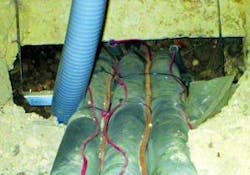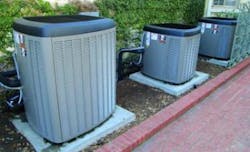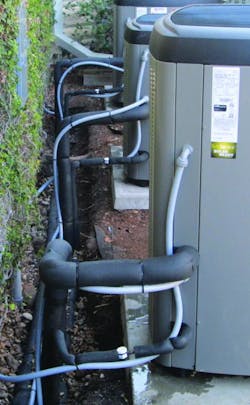2014 Quality Home Comfort Award Winner: Clean Slate Leads to Ideal Comfort
2014 Quality Home Comfort Award Winner:
Retrofit/Renovation More Than 3,000 Sq. Ft.
"Clean Slate Leads to Ideal Comfort"
Rosenberg Indoor Comfort
San Antonio, TX
“In this case, everything was ripped out and we started from scratch, almost as if a new home was being built,” said Joe Incardona, Rosenberg’s sales manager and the designer of the new system. “It’s a large home with a lot of living space laid out in an unusual way that required a lot of thought as to how we were going to deliver air to each room.”
The house, which is owned by Chris Hammet and Keith Sanford, was built in 1951 and is located in the Monte Vista Historic District of San Antonio. The home is about 4,500 square feet and is a single story that sits on pier and beam over a small basement area. The previous gas system was installed in the basement and there was no space to install properly sized return air ducts. In addition, supply air had to be pushed a long way with limited pressure from the basement, up into the attic space, and then across the living area to the farthest rooms.
The home was never comfortable in the extreme temperatures and humidity levels South Texas experiences, and monthly electric bills were typically very high as well. Hammet and Sanford’s goals were to make the entire house comfortable and energy efficient, taking advantage of the best technology available.
When the old system developed a refrigerant leak and needed to be replaced, the homeowners already knew Rosenberg would be the contractor to do the job.
“For over 10 years they’ve been maintaining the old system in the house and keeping it going,” Hammet said. “They’ve always had by far the most professional, experienced technicians. When the system went down and needed replacing with a whole new system, we knew who we were going to go with.”
Their goals were to install a system that wasn’t gas and wasn’t in the basement.
“When this system developed a major issue, they decided they were going to put in a system they could feel comfortable with and that’s going to be more energy efficient,” said Tom Hull, Rosenberg’s vice president. “Joe and I spent quite a bit of time down there, crawling around in their basement, crawling around in the attic, trying to figure out ways we could zone it and the best way to get them what they really wanted.”
Out With the Old
The system being replaced was a 7.5 ton, three-phase condenser, sitting approximately 75 feet from the home. The refrigerant line-set traveled underground to the basement. In the basement were two 15-year-old 80% AFUE furnaces that were “twined” together and installed in an up-flow configuration.
The new design included breaking the home down into three zones, which allowed Rosenberg to create shorter air flow runs and control the temperature in the living space more precisely.
Zone one consisted of the main open living areas of the home. Rosenberg installed the Lennox XP25060 5-ton heat pump with matching CBX40 air handling unit with installed Lennox Healthy Climate Media Filter and 20 KW two-stage auxiliary heat strip. The air handler for this system was installed in the attic space. This system matchup achieved 19.5 SEER.
Zone two consisted of the master bedroom suite and attached media room. The Lennox XP25036 3-ton heat pump with matching CBX40 air handling unit with Lennox Healthy Climate Media Filter and 10 KW auxiliary heat was installed. The air handler for this system was installed in an existing closet space located between the two main areas for the zone. This system matchup achieved 21.5 SEER.
Zone three consisted of a hall area and two guest bedrooms with attached baths. For this area, the Lennox XP21024 2-ton heat pump with matching CBX32MV air handler, Aprilaire Filter Cabinet and 7 KW of auxiliary heat were selected. The air handler for this system was installed in the attic space, in line with the direction of air flow to the two rooms. This system matchup achieved 19.2 SEER.
All three systems communicate via the Lennox I-Comfort WiFi controllers, one in each zone. Shielded control wire ensures reliable communication.
Incardona said he believes Lennox has led the way in the United States in terms of variable capacity systems, and its products were the best fit for this installation.
“For what the homeowners wanted to do, the Lennox top-tier products were pretty much the leading edge within the industry,” he said. “The variable capacity system that we put in, there are very few manufacturers out there fielding those right now.”
Bumps in the Road
Incardona and the rest of the Rosenberg team ran into several smaller challenges with this project, including figuring out how to run the refrigerant lines the way they needed to make sure the equipment would run properly. There were also a few air flow problems that needed to be worked out.
“The homeowners really got involved in the solution as well because when it came to relocating their equipment from the basement to the attic, and their condensing unit, which was at the back alley of their property, all the sudden needed to be moved to the house, they had to redo their incoming power from their meter, from their power pole, new electrical lines in their yard bringing new service into their house,” Hull said. “When you’re working in an existing structure, challenges are at every turn.”
Having a general contractor in the house handling the renovation of the electrical and plumbing could have created challenges, but it actually was a significant help to the HVAC installation. Rosenberg worked alongside the general contractor, not as a subcontractor.
“There was a lot of prep work that needed to be done in order to remove the old equipment and the old existing duct system that we had the general contractor take care of for us,” Incardona said.
“Along the way, as we ran into issues trying to route refrigeration lines or electrical, the general contractor solved some of those problems for us so we could gain access to what we needed to do.”
The general contractor also removed all the insulation in the attic, which was a big advantage for the Rosenberg team, according to Hull.
A Perfect Plan
Despite some glitches, both contractor and homeowners are satisfied with the outcome.
“It went pretty smooth considering it was a scope of project that we don’t normally do,” Incardona said. “Ultimately we solved our customers’ issues. They are very happy with how it came out. They’ve been extremely comfortable in the home. Everything we put together on paper came through pretty much as planned at the end.”
Hammet said he and Sanford are ecstatic with the outcome.
“We went from a big house that had hot spots and cold spots and couldn’t move enough air to one in which the air’s always moving,” he said. “You can’t really tell if the system’s running or not because it’s so quiet. I can even get on the Internet and see what the temperature and humidity in my house are at.
“You get what you pay for,” he said. “Rosenberg probably was not the cheapest around, but they had people who had done this before and obviously knew what they were doing. They carried it off to perfection.”
Elaine Yetzer Simon is a freelance writer based in Cleveland, OH.






